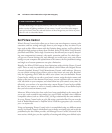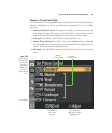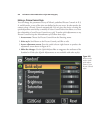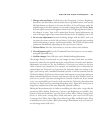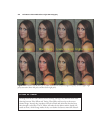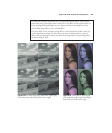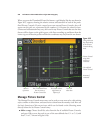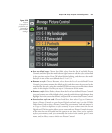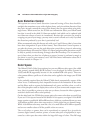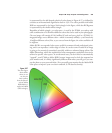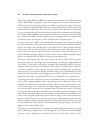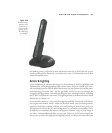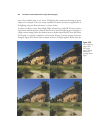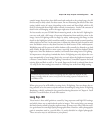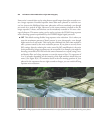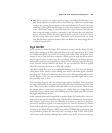Auto Distortion Control
This option can correct barrel distortion (outward bowing of lines that should be
straight) that sometimes occurs with telephoto lenses, and pin-cushion distortion (lines
that curve inwards, towards the center of the frame) that can appear when using wide-
angle lenses. When turned on, the D7000 uses information about your Nikon-brand
lens that is stored in the third (L) firmware module (and which can be updated with
new firmware releases as lenses are introduced). Because this correction can result in
cropping out part of your image, you may want to turn it off and use it only if you find
the distortion produced by your lens is particularly bad.
Nikon recommends using this feature only with type G and D lenses (that is, lenses that
have those designations as part of their names). Auto Distortion Control operates as
you take the picture; you can also apply distortion control after a picture is taken using
the Retouch menu (discussed in Chapter 10). Barrel and pincushion distortion can also
be fully or partially corrected using an image editor like Photoshop. The in-camera fea-
ture is faster when you have lots of photos to process, because it performs its magic as
the photo is saved to your memory card. You’ll find more information about the L
firmware module in Chapter 14.
Color Space
The Nikon D7000’s Color Space option gives you two different color spaces (also called
color gamuts), named Adobe RGB (because it was developed by Adobe Systems in
1998), and sRGB (supposedly because it is the standard RGB color space). These two
color gamuts define a specific set of colors that can be applied to the images your D7000
captures.
You’re probably surprised that the Nikon D7000 doesn’t automatically capture all the
colors we see. Unfortunately, that’s impossible because of the limitations of the sensor
and the filters used to capture the fundamental red, green, and blue colors, as well as
that of the phosphors used to display those colors on your camera and computer mon-
itors. Nor is it possible to print every color our eyes detect, because the inks or pigments
used don’t absorb and reflect colors perfectly.
On the other hand, the D7000 does capture quite a few more colors than we need. Even
if you use 12-bit capture instead of the default 14-bit capture, an original 12-bit RAW
image contains a possible 68 billion different hues, which are condensed down to a mere
16.8 million possible colors when converted to a 24-bit (eight bits per channel) image.
While 16.8 million colors may seem like a lot, it’s a small subset of 68 billion captured,
and an even smaller subset of all the possible colors we can see.
The set of colors, or gamut, that can be reproduced or captured by a given device
(scanner, digital camera, monitor, printer, or some other piece of equipment) is repre-
sented as a color space that exists within the larger full range of colors. That full range
David Busch’s Nikon D7000 Guide to Digital SLR Photography258



